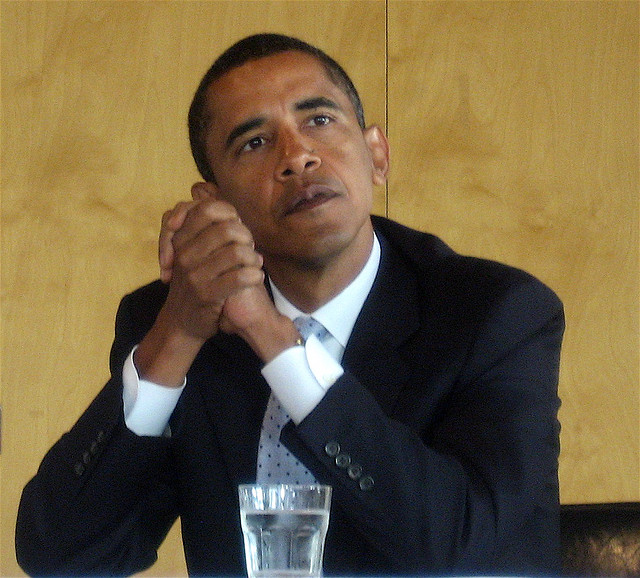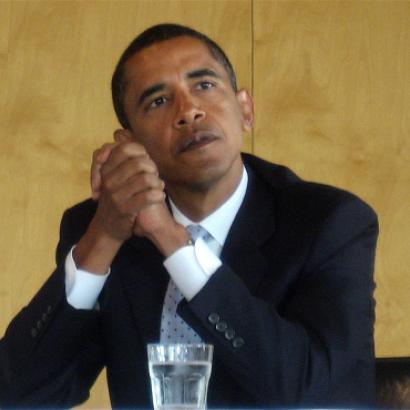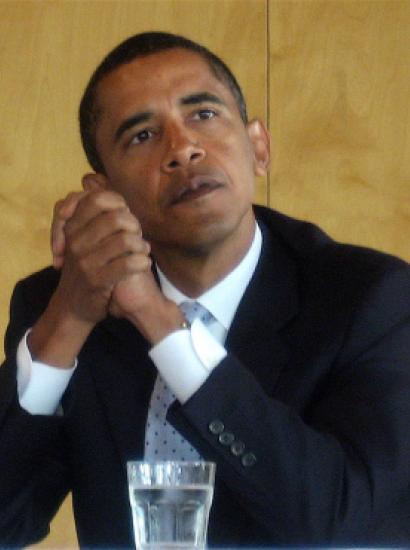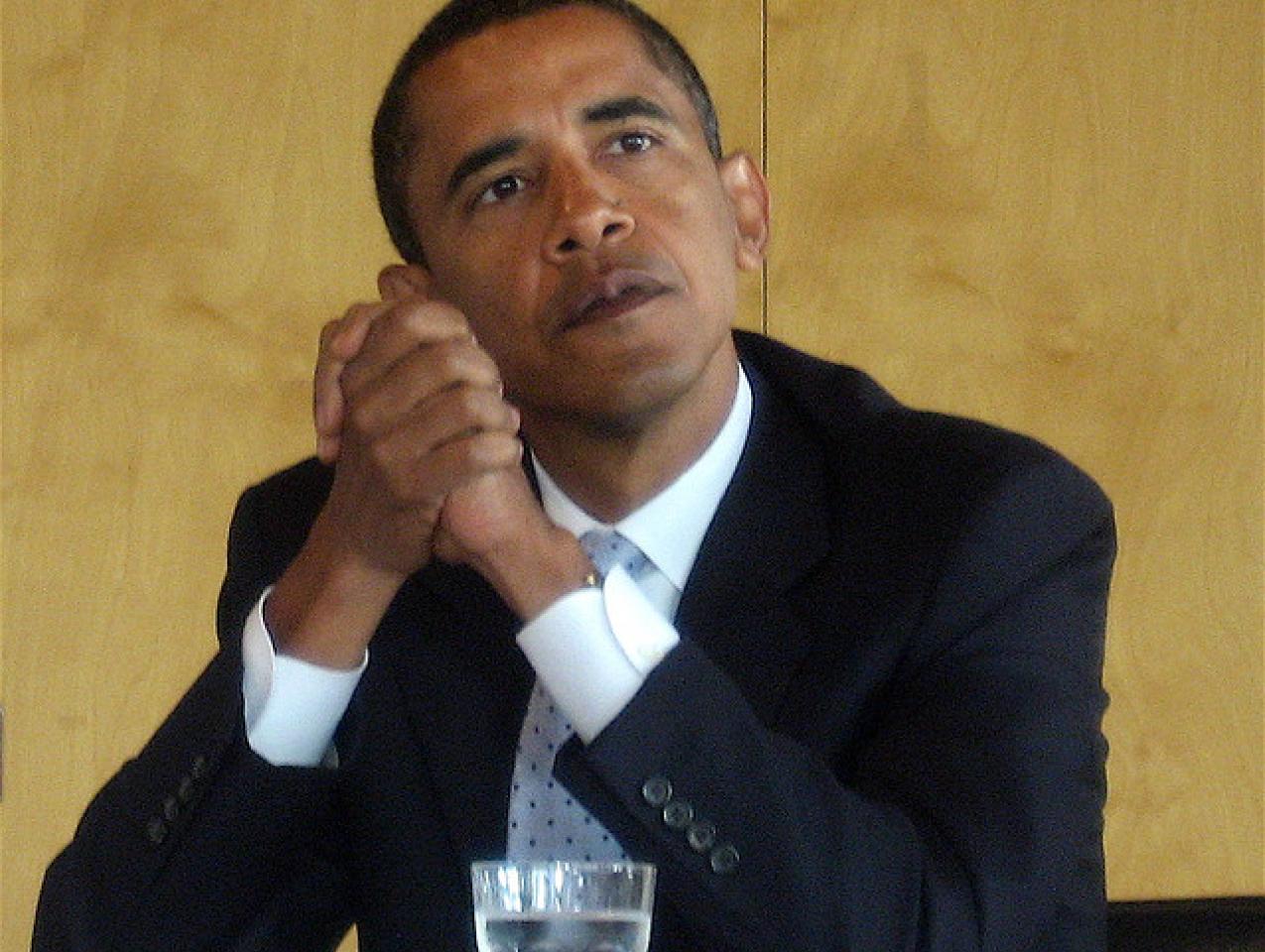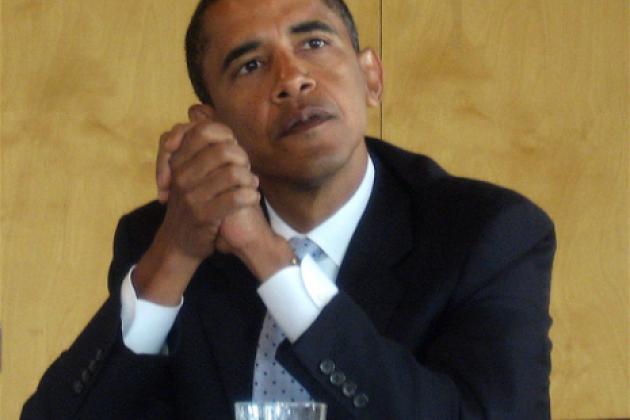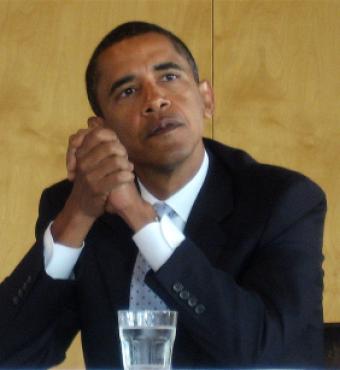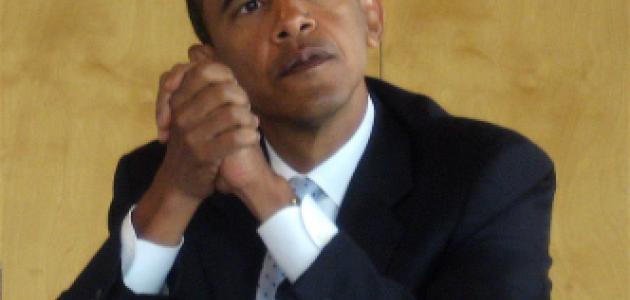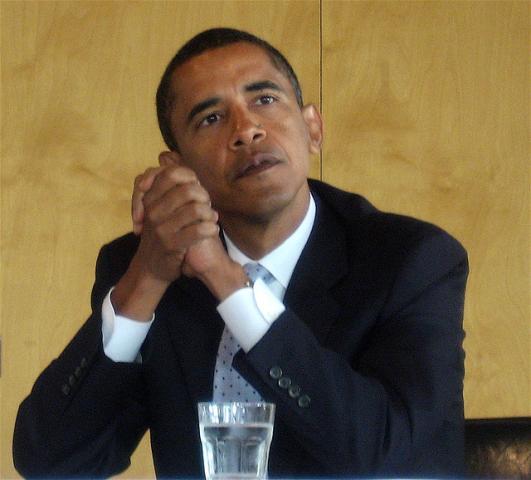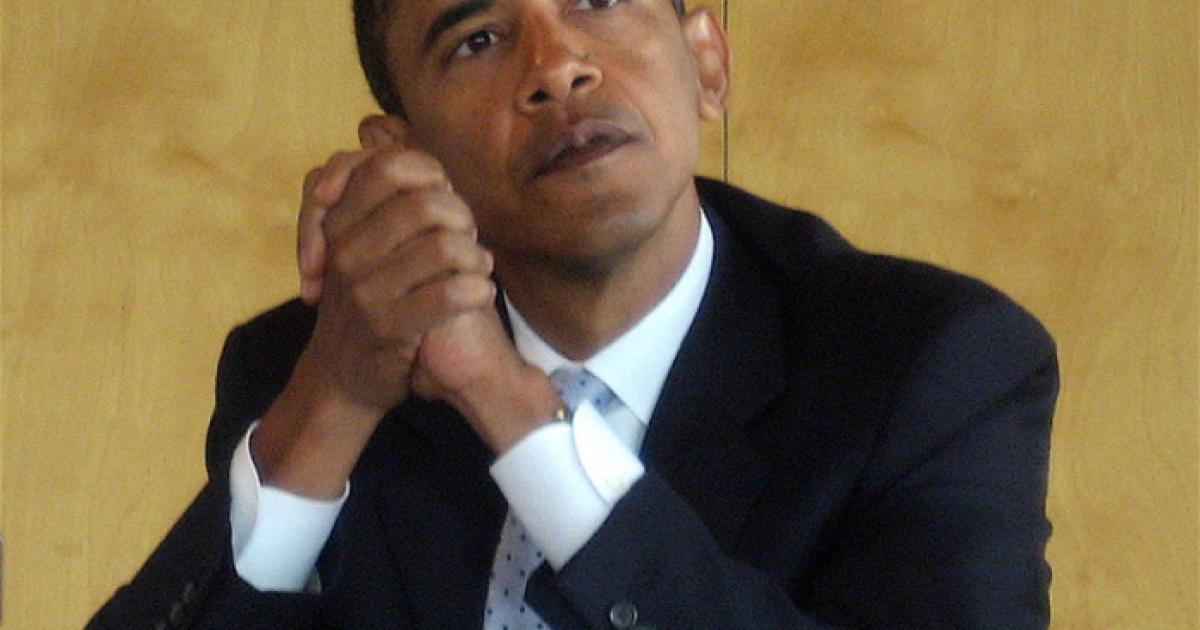- History
- Law & Policy
One of the most closely watched cases before the Supreme Court this term is United States v. Texas, the immigration case that is scheduled to be argued on April 18. The Supreme Court surprised most observers when it asked the parties in that case to address a question they did not raise in their briefs: whether President Obama’s “Deferred Action for Parents of Americans” (DAPA) order violates the “Take Care Clause” of Article II of the Constitution. The Take Care Clause has never before been enforced by the Court and most people have probably never heard of it.
DAPA is a set of executive branch directives giving some four million illegal aliens who have given birth to children in the United States what the orders call “legal presence”—even though they are here in violation of the law. This “legal presence” entitles DAPA beneficiaries to work permits, a picture ID, driver’s licenses, Social Security, Earned Income Tax credits, Medicaid, Obamacare, and other social welfare benefits. Until the 2014 election, President Obama repeatedly and emphatically stated that he did not have authority to issue such an order without congressional action. Then he did it.
Twenty-six states have sued the federal government to challenge the legality of DAPA. The courts below held that the orders violate the Administrative Procedure Act because they were issued without public notice and comment, as is required for agency actions with the effect of law, and because they are in violation of the underlying statute, the Immigration and Nationality Act (INA).
By adding the Take Care Clause to the Questions Presented, the Court is taking care that the constitutional dimensions of this case will not be swamped by the administrative law details. But for most people, including most lawyers, the Take Care Clause is a great unknown—uncharted territory. So: What is the Take Care Clause and what does it mean?
The Take Care Clause, found in Article II of the Constitution, the Executive Power Article, is comprised of only nine words: the president “shall take care that the laws be faithfully executed.” But an understanding of those nine words requires an appreciation of their roots in English history. Like many other structural features of the United States Constitution, the Take Care Clause derives from the long struggle between Parliament and the Crown over the extent of “prerogative powers”—that is, the monarch’s asserted powers to create laws or otherwise to act unilaterally.
Absolute monarchs rule by whim. What they say goes. Even before Parliament existed, however, the barons of England insisted that monarchs rule in accordance with law, rather than mere executive whim or decree. King John (1199–1216) was a major offender against the rule of law. He arbitrarily increased taxes, abused the king’s court, mustered soldiers for military misadventures foreign and domestic, and hanged innocents in Wales. Things came to a head in 1215 at Runnymede. Faced with armed insurrection, John agreed to The Great Charter, which established the principle that the king is not a law unto himself; even the king must act through settled law to bind his subjects.
Thus began a centuries-long struggle between law and royal prerogative. The term prerogative refers to powers invested in the executive that are not governed by law. John Locke defined the term in his Second Treatise on Government: “This power to act according to discretion, for the public good, without the prescription of the law, and sometimes even against it, is that which is called prerogative.” The king’s prerogative powers included the veto, the pardon, the powers of war and peace, the power to create and fill public offices, and the power to dissolve the Parliament. All these he could do without the need for statutes passed by Parliament, and statutes passed by Parliament could not touch, limit, or regulate these prerogative powers.
Prerogative powers are not all inconsistent with constitutional government. Under the Constitution, for example, the president has certain defined prerogatives, such as the pardon power and the veto, which are committed to the president’s discretion. But much of constitutionalism consists of replacing prerogative with law. The framers of the U.S. Constitution carefully reflected on the various prerogative powers claimed or exercised by the English king and granted, denied, or limited those powers when creating the Article II executive.
1. Early Controversies over prerogative powers
One of the most dangerous prerogative powers asserted by English monarchs was the proclamation power: the power to create new law without Parliament’s approval. The term modern Americans would use for proclamations is “executive orders.” Disputes over the proclamation power came to the fore during the Tudor dynasty (1485–1603).
Henry VIII believed his royal proclamations should have the force of law, as “though they were made by act of parliament.” The great Eighteenth Century historian and philosopher David Hume later called this “a total subversion of the English constitution.” After Henry’s death, Parliament repealed the Act of Proclamations.
The struggle over prerogative accelerated under the four Stuart kings prior to the Glorious Revolution of 1688. James I was an ardent believer in the divine right of kings; he wrote a book on the topic shortly before he ascended the English throne, called The Trew Law of Free Monarchies. In James I’s view, kings are unrestrained by law; their authority comes from God, and therefore, the king is accountable only to God—never to man or law.
In 1610, James I issued a royal proclamation prohibiting “new Buildings in and around London” and “the making of starch of wheat.” The legality of these orders was tested in Case of Proclamations. Lord Ellesmere, the royalist jurist, argued that the courts should “maintain the power and prerogative of the King,” and that “in cases in which there is no authority and [precedent],” the judges should “leave it to the King to order it according to his wisdom.” Chief Justice Coke—whose whiggish constitutionalism later informed the views of American framers—held that the King could not lawfully “change any part of the common law, nor create any offence by his proclamation, which was not an offence before, without Parliament.” Coke concluded, “the law of England is divided into three parts, common law, statute law, and custom; but the King’s proclamation is none of them.”
Chief Justice Coke reiterated the point in the Case of Non Obstante, or Dispensing Power. Coke observed that the king does have some prerogative powers. For example, a royal pardon grants mercy notwithstanding (or, as English lawyers said at the time, non obstante) the lawful conviction. But Coke insisted that the king’s non obstante (or dispensing) power never can be used to annul statutes. If the king attempted to dispense with a statute, Coke held, the king’s effort would be “void,” for “an act of Parliament may absolutely bind the King.”
The principles of the Case of Proclamations and the Case of Non Obstante are part of the American constitutional tradition. The Steel Seizure Case of 1952, our Supreme Court’s foundational separation-of-powers decision, held that the President cannot make law; that is exclusively Congress’s job. In other words, executive orders have the force of law only when implementing statutes, treaties, and the Constitution—that is, the sources of “law” defined by the Supremacy Clause.
Notably, many if not all of these controversies over the reach of royal prerogative arose when the king took a precedent that prior monarchs had used in modest and relatively uncontroversial ways—as Elizabeth had funded defense against the Spanish Armada—and stretched it to cover significant usurpations of power in ways contrary to the will of Parliament. That has continued to be the pattern in American separation of powers struggles, including the one over DAPA.
2. Charles II and the Suspending Power
The most important struggles over prerogative during the Restoration period (1660-1688) involved the suspension and dispensing powers: the power to suspend the execution of a law, and the power to grant dispensations or indulgences permitting people or corporations to act in ways that would otherwise be unlawful, notwithstanding (or non obstante) the law. As defined by a leading historian, “the power to suspend a law was the power to set aside the operation of a statute for a time. It did not mean, technically, the power to repeal it. The power to dispense with a law meant the power to grant permission to an individual or a corporation to disobey a statute.”
The principal flashpoint in the Restoration-era struggles over the suspension and dispensing powers was the question of religion. Charles II secretly and James II openly professed the Roman Catholic faith, which was awkward given that the king was supreme head of the “church by law established,” the Church of England. At that point, dissenters from the Church of England were regarded as potentially rebellious and dangerous. In then-recent memory, radical Protestants had overthrown the government in the English Civil War, and real or imagined “Popish Plots” were thought an ever-present danger to political stability.
Charles and James sought legal protections for their fellow Catholics, but this was anathema to the Anglican-dominated Parliament. Rather than protecting Catholics, Parliament statutorily excluded them from various offices and jobs.
On March 15, 1672, Charles II issued a Declaration of Indulgence, unilaterally suspending the penal laws against Catholics and Protestant nonconformists. Speaking in the royal first person plural, the King decreed: “We do . . . declare our will and pleasure to be, that the execution of all, and all manner of penal laws in matters ecclesiastical, against whatsoever sort of nonconformists, or recusants, be immediately suspended, and they are hereby suspended.”
Charles II’s unilateralism enraged Parliament, which forced the king to rescind the declaration. In its place, Parliament enacted the Test Act of 1672, which limited public office to persons willing to forswear belief in the Catholic doctrine of transubstantiation, and to take communion in the Church of England.
3. James II and the Dispensing Power
On his brother’s death in 1685, James II assumed the throne. Not willing to rely on Protestant militias and local gentry for protection against rebellion, he attempted to create a standing army and to place it under the control of Catholic officers. To achieve this end, he granted “dispensations” from the Test Act, which allowed Catholics to hold high civil and military offices notwithstanding Parliament’s legislation to the contrary.
A parliamentary address responded that the Test Act “can no way be taken off but by an act of parliament.” James then disbanded the Parliament, fired judges he expected to be uncooperative, and arranged a test case, Godden v. Hales. With one dissent, the court concluded “that the Kings of England were absolute Sovereigns; that the laws were the King’s law; that the King had a power to dispense with any of the laws of Government as he saw necessity for it; [and] that he was the sole judge of that necessity.”
Emboldened by Godden, James II suspended the ecclesiastical laws by issuing his own Declaration of Indulgence:
that from henceforth the execution of all and all manner of penal laws in matters ecclesiastical . . . be immediately suspended; and the further execution of the said penal laws and every of them is hereby suspended.
In 1688, James reissued the Declaration of Indulgence with the requirement that Anglican clergy read it aloud from their pulpits. The famed “Seven Bishops”—the Archbishop of Canterbury and six others—petitioned the king to withdraw the order, disputing its legality. James charged the bishops with seditious libel. The alleged libel was that the bishops falsely denied the king’s power to suspend the Test Act and to grant dispensations from it. Remarkably, the King’s Bench split 2-2.
The most ardent defender of the bishops was Justice John Powell. In explaining his vote against the king and the exercise of his dispensing power, Justice Powell observed:
Now, gentlemen, this . . . dispensation . . . amounts to an abrogation and utter repeal of all the laws; for I can see no difference, nor know of none in law, between the king’s power to dispense with laws ecclesiastical, and his power to dispense with any other laws whatever. If this be once allowed of, there will need no parliament; all the legislature will be in the king, which is a thing worth considering, and I leave the issue to God and your consciences.
With that spirited indictment of the king’s dispensing power, the court sent the case to a jury. The jury, in turn, acquitted the bishops. When the verdict was announced, the people of London took to the streets in noisy celebration, which quickly turned into anger against James II and his executive overreach. Leading citizens invited the husband of James’s eldest daughter, William of Orange, to depose James II and assume the English throne as co-monarch with his wife.
The next year, in 1689, Parliament enacted English Bill of Rights, a list of principles of government that, along with Magna Charta and the Petition of Right, formed the most important features of the British Constitution. The first two provisions of the Bill of rights stated: “That the pretended Power of Suspending of Laws, or the Execution of Laws, by regal Authority, without Consent of Parliament, is illegal.” The second provision stated: “That the pretended power of dispensing with laws, or the execution of laws, by regal authority, as it hath been assumed and exercised of late, is illegal.”
4. The U.S. Constitution Incorporates the British Rejection of the Suspending and Dispensing Powers
Consistent with the British constitution, at the Founding, at least three States affirmatively outlawed the suspension and dispensing powers prior to the U.S. Constitution. The Virginia Declaration of Rights of 1776, for example, provided “that all power of suspending laws, or the execution of laws, by any authority without consent of the representatives of the people, is injurious to their rights and ought not to be exercised.”
When the Framers met in Philadelphia in 1787, they too discussed the royal prerogative to suspend laws or grant dispensations. The delegates to the Constitutional Convention first took up the executive power plank of the Virginia Plan (Resolution 7) on June 1, 1787. Resolution 7 vested in the executive all “Executive rights” that had been vested in Congress under the Articles of Confederation. Immediately, delegates worried that an unlimited grant of “executive” power would include the royal prerogative powers, such as to make “peace & war.” John Rutledge, who arguably had been the most capable wartime state executive in the nation, wished to achieve the benefits of a unitary executive “tho’ he was not for giving” the executive the full range of royal prerogative powers. James Wilson declared that “he did not consider the Prerogatives of the British Monarch as a proper guide in defining the Executive powers.” The delegates voted to vest the executive only with the powers to “carry into effect, the national laws” and the power of appointment.
Three days later, on June 4, the delegates debated whether to give the executive an absolute veto on legislation—one of the prerogatives of the Crown that had survived the Glorious Revolution. Benjamin Franklin rose and expressed his concerns: “The first man, put at the helm [of the presidency] will be a good one. No body knows what sort may come afterwards. The Executive will be always increasing here, as elsewhere, till it ends in a monarchy.” The Convention voted to allow Congress to override the executive’s veto.
Then Pierce Butler of South Carolina moved the question whether “the National Executive [would] have a power to suspend any legislative act for a term of [time].” Elbridge Gerry worried “that a power of suspending might do all the mischief dreaded from the [veto] of useful laws; without answering the salutary purpose of checking unjust or unwise ones.” As Madison reports, “On question ‘for giving this suspending power’ all the States . . . were no.” The very idea of a suspending power was unanimously rejected, never to be proposed again.
On July 26, the Convention referred the executive power question to the Committee on Detail, which was chaired by Rutledge and dominated intellectually by Wilson, two of the delegates who had expressed concern about executive prerogative on June 1. The draft Constitution at that point vested a “single person” with “power to carry into execution the national laws.” The Committee changed this to read: “he shall take care that the laws of the United States be duly and faithfully executed.” As a result, the execution of the law became a duty rather than power, as indicated by the word “shall.” This effectively precluded any assertion of a dispensing or suspending power.
The Take Care Clause’s rejection of the suspending and dispensing powers is so unambiguous that it has been accepted even by the executive branch. In United States v. Smith, (1806), the defendants claimed the president had authorized their violation of the Neutrality Act. President Jefferson’s lawyers countered that under the Take Care Clause, the president “cannot suspend [the Act’s] operation, dispense with its application, or prevent its effect . . . If he could do so, he could repeal the law, and would thus invade the province assigned to the legislature, and become paramount to the other branches of the government.” Supreme Court Justice William Paterson—a signatory of the Constitution—agreed that the Take Care Clause “explicitly” denies the President a “dispensing power.” Later, President Clinton’s Attorney General Benjamin Civiletti declared that “the history of that dispute [over the Stuarts’ ‘dispensing power’] was well-known to the Framers of the Constitution, and it is clear that they intended to deny our President any discretionary power of the sort that the Stuarts claimed.”
By framing the Take Care Clause as a duty, the framers rejected the idea that the President should be vested with the prerogative powers of suspension or dispensing with the laws. When President Andrew Jackson argued that the Take Care Clause made him the sole judge of whether the laws were being faithfully executed, the Supreme Court responded in Kendall v. United States ex rel. Stokes (1838): “To contend that the obligation imposed on the President to see the laws faithfully executed, implies a power to forbid their execution, is a novel construction of the constitution, and entirely inadmissible.” The Court added that this “would be vesting in the President a dispensing power, which has no countenance for its support in any part of the constitution” and recognizing such a principle “would be clothing the President with a power entirely to control the legislation of congress.”
5. The DAPA Rule Falls Precisely Within the Category of the Dispensing Power, Which is Barred by the Take Care Clause
Apart from its subject matter, the executive action challenged in this case precisely parallels James II’s use of the dispensing power. The Immigration and Naturalization Act defines persons who entered this country without authorization and do not fall into any of its specific exceptions as being here unlawfully. That includes the beneficiaries of the DAPA order. Among the consequences of unlawful presence are ineligibility for work permits and for many social welfare programs. Moreover, the INA expressly provides that every day a DAPA beneficiary spends in the United States should accrue as time under the individual’s unlawful-presence clock. These consequences were set by Congress for the purpose of discouraging illegal immigration. And unlike deportation, which necessarily involves enforcement discretion, these consequences are absolute—unless there is an explicit statutory exception, these consequences apply to every person in this country unlawfully.
Under the DAPA rule, some four million people who are unlawfully present in the United States under the statute have been given the dispensation to remain and to obtain work permits and social welfare benefits. Their unlawful-presence clocks do not run. This is not mere non-enforcement. It is not an exercise of prosecutorial discretion. It is not a matter of enforcement priorities. Like James II’s dispensations, DAPA permits “an individual . . . to be lawfully present in the United States,” notwithstanding the INA’s provisions to the contrary. Until such time as it might be revoked, its beneficiaries are no longer in violation of the law. Because the executive officials who promulgated DAPA are acting outside their statutory authority, and are making lawful what Congress has declared unlawful, they are in violation of the Take Care Clause of Article II.
6. Reversal Would Portend Limitless Executive Power
Using handpicked judges, James II won the judicial imprimatur of his declaration suspending the Test Act, and he used that precedent to justify ever-increasing exercises of executive power. Should the Supreme Court uphold the DAPA orders, future Presidents—be they Hillary Clinton, Donald Trump, or someone else—will have an equally potent and dangerous precedent at their disposal. The question in any future case, as in this one, is not whether the president’s rule makes good policy; the question is whether the Constitution allows the president to license statutory violations. It does not.
For example, suppose a future president tries and fails to lower the capital gains rate to 15 percent. That president could declare that the IRS will “prioritize” capital gains collections under 15 percent and invite taxpayers to send in forms requesting settlements for that amount. The president could point to statutory authority for tax settlements. And the president could revoke the policy at any time. But for as long as the policy remained in effect, under petitioners’ rule in this case, taxpayers would get the benefit of the lower rate.
Or suppose a future president determines that environmental protection laws hurt the economy. If that president fails to convince Congress to amend or repeal the statutes, the president instead could issue permits allowing polluters to emit noxious chemicals into the environment with impunity. The president even could pretend that the dispensations accord with congressional intent to consider the job-killing costs of environmental regulations. Again, those permits could be revoked at will. But for as long as the permits are valid, under petitioners’ rule in this case, the permittee could do myriad things that the environmental laws flatly prohibit.
Or suppose a past president wanted to give federal education grants to universities that refuse to follow the civil rights laws, in violation of Title VI. That president could claim enforcement discretion to “negotiate” “voluntary compliance” with the civil rights laws, rather than cutting off funds entirely as Congress required. Under petitioners’ rule here, President Nixon would have had unreviewable discretion to do just that. Nixon’s orders granting discriminatory southern universities a reprieve were struck down by the courts in a case called Adams v. Richardson (1973). It is hard to see why DAPA is any different.
The President was correct in October 2010 when he recognized that only Congress can lawfully effectuate DAPA. As he said then: “I am president, I am not king. I can’t do these things just by myself.” Indeed, even James II could not do these things by himself. The Framers adopted the Take Care Clause to ensure that the executive in this republic is likewise forbidden to make law unilaterally. That is why the duty to “take care” means so much.
Editor’s note: This article is based on the author's amicus brief in United States v. Texas on behalf of various state governors.







